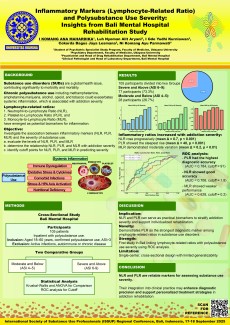Inflammatory Markers (Lymphocyte-Related Ratio) and Polysubstance Use Severity: Insights from a Bali Mental Hospital Rehabilitation Study

Background:
Substance use disorders (SUDs) are a global health issue, contributing significantly to morbidity and mortality. Chronic polysubstance use exacerbates systemic inflammation, which is associated with addiction severity. Lymphocyte-related ratios, such as Neutrophil-to-Lymphocyte Ratio (NLR), Platelet-to-Lymphocyte Ratio (PLR), and Monocyte-to-Lymphocyte Ratio (MLR), have emerged as potential biomarkers for inflammation in SUD. This study evaluated the diagnostic utility of these ratios.
Methods:
A cross-sectional study was conducted at Bali Mental Hospital among 105 patients undergoing rehabilitation for polysubstance use. Participants aged 18–60 years with a confirmed diagnosis of polysubstance use were included. Patients with active infections, autoimmune diseases, or chronic conditions were excluded. Participants were categorized into two groups: Moderate and Below (Addiction Severity Index, ASI 4–5) and Severe and Above (ASI 6–9). Group comparisons were performed using Kruskal-Wallis and ANOVA tests based on normality. ROC analysis evaluated diagnostic accuracy and optimal cutoff values.
Results:
Significant differences were observed for all lymphocyte-related ratios between groups. Mean differences (Δ) were NLR (Δ = 0.7, p<0.001), PLR (Δ = 40, p<0.001), and MLR (Δ = 0.2, p<0.01). ROC analysis revealed PLR had the highest diagnostic accuracy (AUC = 0.769, cutoff = 91.05), followed by NLR (AUC = 0.709, cutoff = 1.83). MLR showed moderate accuracy (AUC = 0.641, cutoff = 0.20).
Conclusion:
NLR and PLR are reliable markers for assessing substance use severity. Their integration into clinical practice may enhance diagnostic precision and support personalized treatment strategies in addiction rehabilitation.
Keywords: Lymphocyte-Related Ratios, NLR, PLR, MLR, Polysubstance Use
